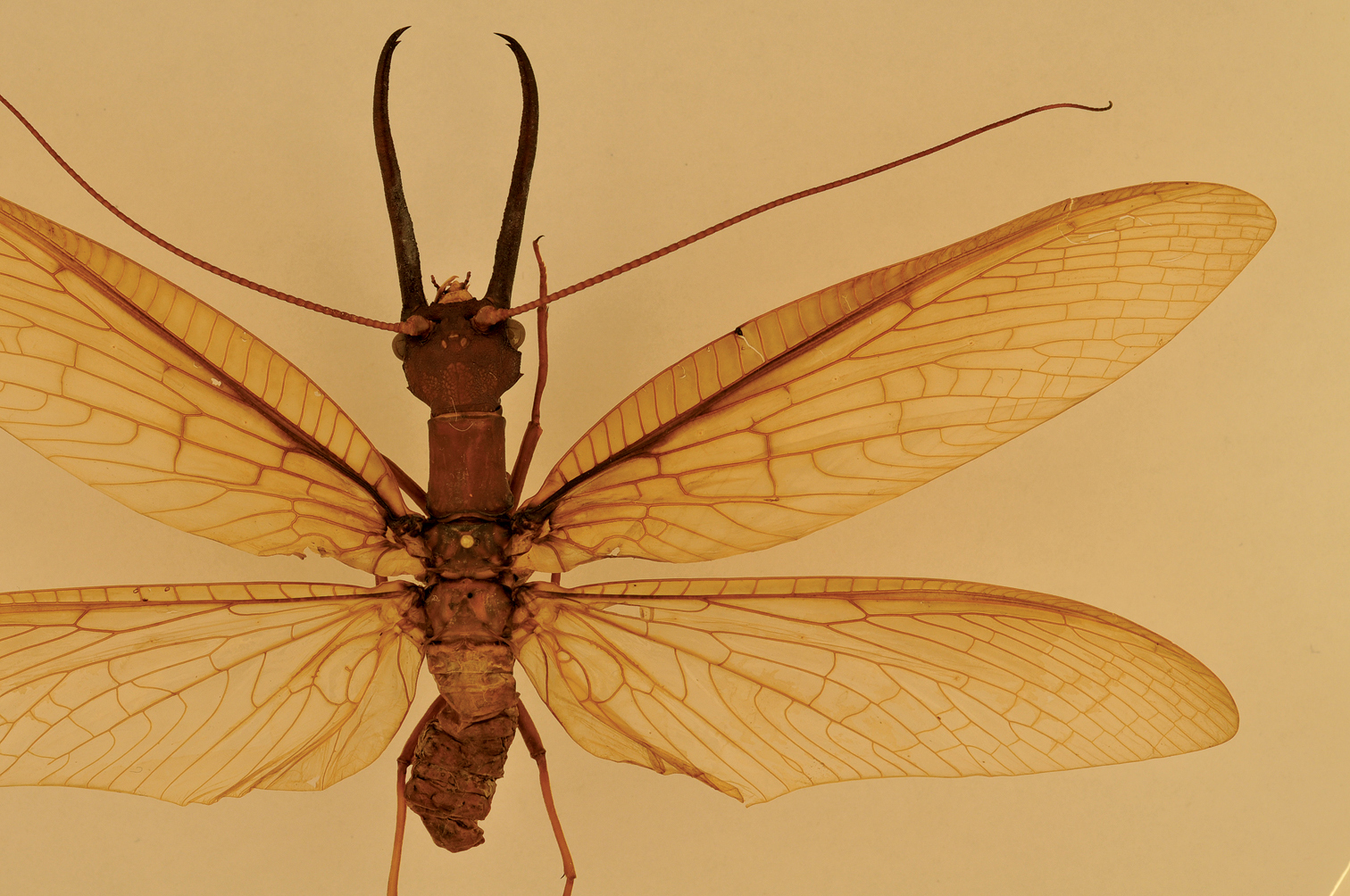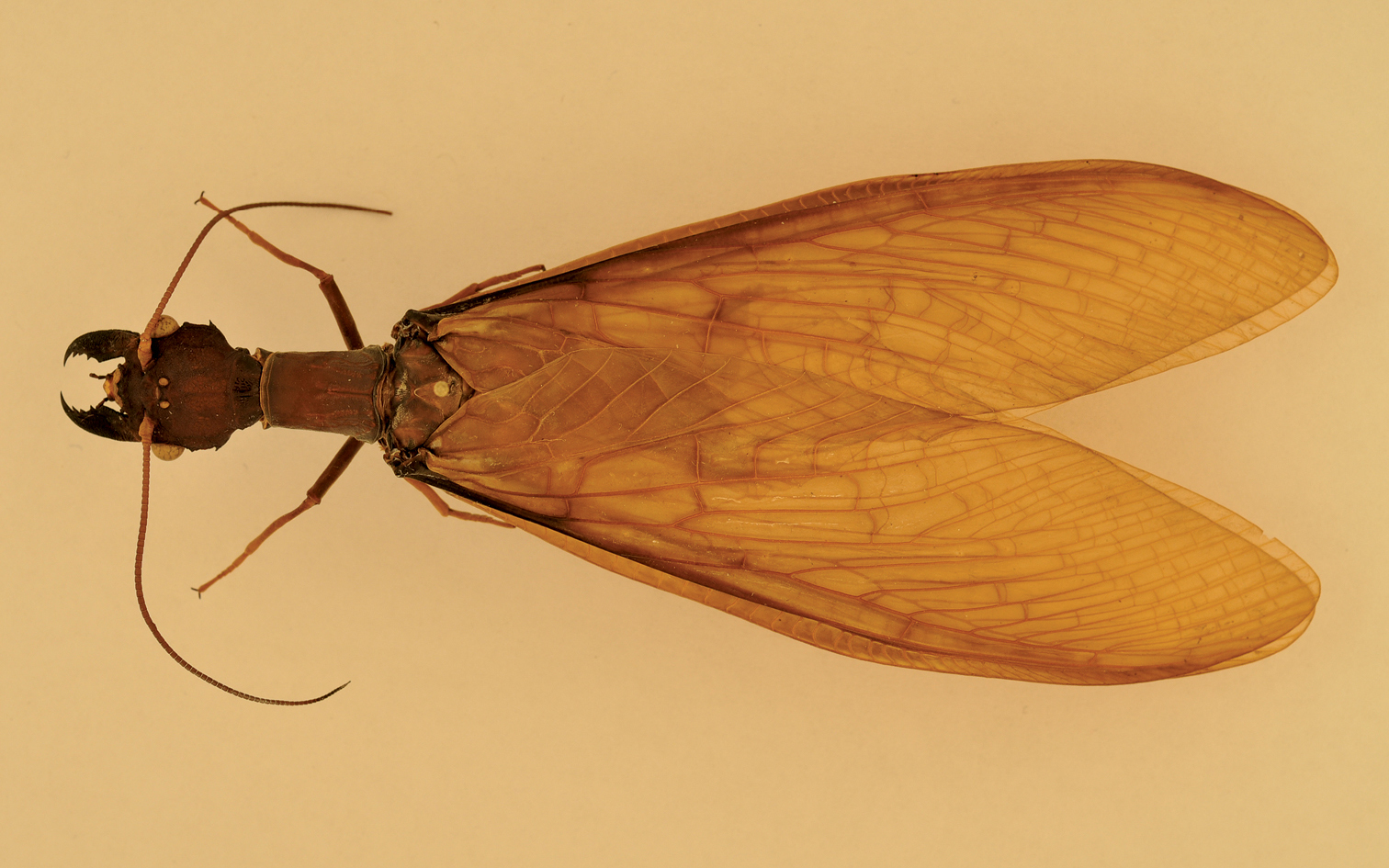(C) 2010 Atilano Contreras-Ramos. This is an open access article distributed under the terms of the Creative Commons Attribution License, which permits unrestricted use, distribution, and reproduction in any medium, provided the original author and source are credited.
For reference, use of the paginated PDF or printed version of this article is recommended.
A new species of dobsonfly, Corydalus wanningeri, from Venezuela, is described and illustrated. It superficially resembles Corydalus neblinensis Contreras-Ramos, with a uniform reddish coloration of body and wings. Yet, because of male genitalic structure it might be closely related to Corydalus crossi Contreras-Ramos. Specimens were collected from a rain forest transitional zone between the Orinoco lowlands and the Gran Sabana plateau, in Bolívar state. This is the 15th species of Corydalus to be recorded from Venezuela, rendering this the country with the highest number of documented Corydalus species. A key to the sexually dimorphic, long-mandibled Venezuelan species of the genus is provided.
Dobsonfly, taxonomy, biodiversity, South America, key
The dobsonfly genus Corydalus Latreille was revised nearly a decade ago (
Late last year the authors established contact. From images of a collection of Neotropical dobsonflies, a series of Corydalus specimens stood out as potentially new, a supposition corroborated upon specimen examination. Specimens of the new species had been collected by Professor Rupert Wanninger of Bavaria, where he is now a retired teacher of arts and sports. Prof. Wanninger is also a recognized amateur entomologist, deeply versed in Natural History, with extensive experience in breeding of exotic beetles. For years, he has motivated young people in an interest and respect for Nature. This contribution is in homage to Prof. Wanninger’s lifetime as an educator and insect lover.
Table 1. Species of Corydalus Latreille recorded from Venezuela (
| Species | Distribution |
|---|---|
| Corydalus affinis Burmeister, 1839 | Argentina, Bolivia, Brazil, Colombia, Ecuador, French Guiana, Guyana, Paraguay, Peru, Venezuela |
| Corydalus armatus Hagen, 1861 | Argentina, Bolivia, Colombia, Ecuador, Peru, Venezuela |
| Corydalus arpi Navás, 1936† | Brazil, Venezuela |
| Corydalus batesii MacLachlan, 1868 | Bolivia, Brazil, Colombia, Ecuador, French Guiana, Guyana, Peru, Suriname, Venezuela |
| Corydalus clavijoi Contreras-Ramos, 2002 | Venezuela |
| Corydalus crossi Contreras-Ramos, 2002 | Venezuela |
| Corydalus flavicornis Stitz, 1914 | Colombia, Costa Rica, Ecuador, El Salvador, Guatemala, Honduras, Panama, Peru, Venezuela |
| Corydalus flinti Contreras-Ramos, 1998† | Venezuela |
| Corydalus hayashii Contreras-Ramos, 2002† | Venezuela |
| Corydalus hecate MacLachlan, 1866† | Brazil, Peru, Venezuela‡ |
| Corydalus mayri Contreras-Ramos, 2002† | Venezuela |
| Corydalus neblinensis Contreras-Ramos, 1998 | Venezuela |
| Corydalus nubilus Erichson, 1848 | Brazil, French Guiana, Guyana, Venezuela |
| Corydalus peruvianus Davis, 1903 | Argentina, Bolivia, Colombia, Costa Rica, Ecuador, Guatemala, Mexico, Panama, Peru, Venezuela |
| Corydalus tesselatus Stitz, 1914 | Colombia‡, Venezuela |
| Corydalus wanningeri sp. n. | Venezuela |
Isolated single specimens from a single site were
collected by Prof. Wanninger, amounting to about 40 collections over a
more than a 10 year span. All specimens were collected using mercury
vapor light. The collecting site is located adjacent to the NE limit of
Parque Nacional Canaima, in a portion of a winding road known as La
Escalera (Spanish for ladder), highway 10, between Piedra de la Virgen
and Danto Falls, around Km 110–112, at 1, 000 m of elevation. A large
communications antenna is a landmark for the collecting site. Highway
10 connects the Orinoco lowlands with the Gran Sabana plateau in the
south. La Escalera is a humid slope covered with rain forest, with
several brooks and waterfalls, potential habitat for the hellgrammites.
Collections by Prof. Wanninger from nearby sites at higher and lower
elevations did not produce any more specimens of the new species.
Specimens were dissected and observed using standard techniques (
Specimens will be deposited at Colección Nacional de
Insectos, Instituto de Biología, UNAM, Mexico City (CNIN-UNAM),
Museo del Instituto de Zoología Agrícola, Universidad Central de
Venezuela, Maracay (MIZA), Zoologische Staatssammlung München,
Bavaria, Germany (ZSM), and Prof. Wanninger’s private collection (RW).
The identification key herein provided applies to species with males
whose mandibles are elongate, with reduced dentition. Species with
males having short, female-like mandibles may be identified with
urn:lsid:zoobank.org:act:D8CD9346-1591-4C3D-8898-A5145867FB18
Figures 1–8Named after Prof. Rupert Wanninger, amateur and outreach entomologist from Donaustauf, Bavaria, Germany, collector of the type series.
Holotype, male, VENEZUELA: Bolívar, Escalera Km 110, el. 1, 000 m, 26.viii.1994, leg. Rupert Wanninger [Head width 11.8 mm, mandible length 29.5 mm, antenna length 65.3 mm, forewing length 80.4 mm] (CNIN-UNAM). Paratypes: VENEZUELA, [Bolívar], Guyana, Km 120, 1997, 1 male [genitalia dissected] (MIZA); [Bolívar], Escalera, [Km 110, 1, 000 m], 25.viii. 1999, [R. Wanninger], 1 female [genitalia dissected] (CNIN-UNAM); Bolívar, Escalera, Km 110, 1, 000 m, 2.ii.2001, leg. R. Wanninger, 1 female (ZSM); [Bolívar, Escalera, Km 110, no date, R. Wanninger], 1 male (ZSM), 1 female (RW).
Corydalus wanningeri, sp. n. Male holotype, habitus.
Corydalus wanningeri, sp. n. Female paratype, habitus.
Head and pronotum are reddish-brown, ferrugineous (Fig. 1–3), thus resembling in color species such as Corydalus cephalotes Rambur and Corydalus hecate MacLachlan, both with monomorphic mandibles (males with short mandibles with discrete dentition), or Corydalus batesii MacLachlan and Corydalus holzenthali
Contreras-Ramos, with sexually dimorphic mandibles (males with
elongate mandibles with reduced dentition). However, both color of body
and wings most closely resembles Corydalus neblinensis Contreras-Ramos (
Corydalus wanningeri, sp. n. Female paratype, head and pronotum (dorsal).
Despite a close superficial resemblance to Corydalus neblinensis, Corydalus wanningeri sp. n., does not appear to be closely related to that or other kindred species, such as Corydalus batesii or Corydalus holzenthali. The new species appears to be closest to Corydalus crossi
Contreras-Ramos, because of the structure of the 10th sternite and a
basal protrusion of the 9th gonostylus. If so, the new species would be
basal among species with elongate mandibles. At least, Corydalus wanningeri
sp. n., should be basal with respect to species with a subclavate 9th
gonostylus and non-incurvate 10th tergite, and so would lay out of
Unnamed Group 1 (
Head width 11.8–12.8 mm (average 12.3, n = 3), mandible length 29.5–30.3 mm (average 29.9 mm, n = 3), antenna length 64.5–65.3 mm (average 64.9 mm, n = 2), forewing length 77.7–80.4 mm (average 79.5 mm, n = 3), antenna length/forewing length 0.81–0.83. Color uniform dark reddish-brown. Head dark reddish-brown, unpatterned, mandible elongate with reduced dentition (Figs 1). Clypeal margin thinly black, lateral projections moderately developed, flat to slightly concave, median projection shallowly incised (Fig. 7). Antenna 87–89-segmented, filiform, scape and flagellum pale brown, tip infuscate. Maxilla blackish, 4-segmented palp brown. Labial palp 3-segmented, pale brown, last segment elongate.
Pronotum dark reddish-brown, unpatterned. Forewing pale reddish-brown, semitranslucent, unpatterned; veins reddish-yellow, except basal half of Sc and R infuscate; M1+2 3-branched (variably 4-branched), M3+4 a single vein. Hindwing pale-reddish, semitranslucent, basal 1/4 of R infuscate.
Genitalia (Figs 4–6). Ninth tergum subquadrate, V-shaped internal inflection reaching midlength of tergum. Anal tubercle without lateral sclerites. Tenth tergites slightly longer than ninth tergum, digitiform; basal 1/3 wide, roundly concave (Fig. 4). Ninth gonostylus subclavate, about 4/5 as long as 10th tergite, with narrowed digitiform apex (Fig. 5). Ninth sternum subquadrate, semimembranous, posterolateral lobes moderately developed (Fig. 5). Membrane between 9th and 10th sternites with thickened wrinkled portion. Tenth sternite moderately convex, anteromedian margin slightly convex; anterolateral projections moderately developed, blunt; lobes well sclerotized, elongate-trianguloid, apically convergent (Fig. 6). Pregenital sacs apparently absent.
4 Corydalus wanningeri sp. n. 4 male genitalia (dorsal) 5 male genitalia (ventral).
Forewing length 65.1–80.6 mm (average 74.1 mm, n = 3). Color of body and wings similar to male (Figs 2, 3). Mandible with base dark reddish-brown, rest blackish; shape similar to Corydalus nubilus Erichson and Corydalus crossi, basal preapical tooth moderately separated from second (Fig. 8;
Terminalia non distinct. Sternal pouch between 6th and 7th abdominal segments well developed. Eighth sternum moderately sclerotized, discontinuous with pleural area, posterior margin mesally semimembranous, concave.
| 1. | Ninth sternum modified, subattenuate and more sclerotized posteromesally ( |
2 |
| – | Ninth sternum unmodified, subquadrate (Fig. 5; |
4 |
| 2. | Ninth sternum subattenuate, noticeably more sclerotized posteromesally ( |
Corydalus nubilus Erichson |
| – | Ninth sternum with posteromedian projection | 3 |
| 3. | Posteromedian projection of 9th sternum large (nearly as long as sternum), thumblike; 9th gonostylus unguiform ( |
Corydalus tesselatus Stitz |
| – | Posteromedian projection of 9th sternum
small (about 1/2 as long as sternum), narrow; 9th gonostylus tubular,
with conspicuous preapical claw ( |
Corydalus clavijoi Contreras-Ramos |
| 4. | Ninth gonostylus elongate, somewhat flattened or tubular ( |
5 |
| – | Ninth gonostylus subclavate (Fig. 5; |
6 |
| 5. | Ninth gonostylus and 10th tergite slender, subequal in length and shape ( |
Corydalus affinis Burmeister |
| – | Ninth gonostylus narrower and noticeably shorter than 10th tergite ( |
Corydalus crossi Contreras-Ramos |
| 6. | Head and pronotum reddish brown; 10th tergite apex without incurvation (Fig. 5), although it may be enlarged ( |
7 |
| – | Head and pronotum yellowish to greenish brown; 10th tergite with well developed apical incurvation ( |
9 |
| 7. | Forewing contrastingly patterned ( |
Corydalus batesii MacLachlan |
| – | Forewing not so contrastingly patterned | 8 |
| 8. | Forewing pale, clear, nearly translucent, few subtle small white spots ( |
Corydalus neblinensis Contreras-Ramos |
| – | Forewing rather opaque, uniformly pale reddish (Fig. 1); 9th gonostylus with narrowed digitiform apex, 10th sternite lobes elongate-trianguloid, close to each other (Figs 5, 6) | Corydalus wanningeri, sp. n. |
| 9. | Antenna conspicuously subserrate, sinuate ( |
Corydalus flavicornis Stitz |
| – | Antenna slightly subserrate; 10th sternite without anteromedian projection ( |
10 |
| 10. | Antenna, including scape and pedicel, pale to dark brown, apically infuscate ( |
Corydalus armatus Hagen |
| – | Antenna, including scape and pedicel, yellow to yellowish green, up to distal 1/3 infuscate ( |
Corydalus peruvianus Davis |
Corydalus wanningeri sp. n. Male tenth sternite.
Corydalus wanningeri sp. n. Male clypeal margin (dorsal).
Corydalus wanningeri sp. n. Female mandible (right, dorsal).
Help with line drawings by Jorge A. González Martínez is greatly appreciated. Comments from David E. Bowles, Missouri State University, and an anonymous reviewer, improved a previous draft of this paper. Institutional support to ACR from Biblioteca (Georgina Ortega), Jefatura de Zoología (Patricia Escalante), Secretaría Técnica (Noemí Chávez), and Dirección (Tila M. Pérez) is gratefully appreciated.













